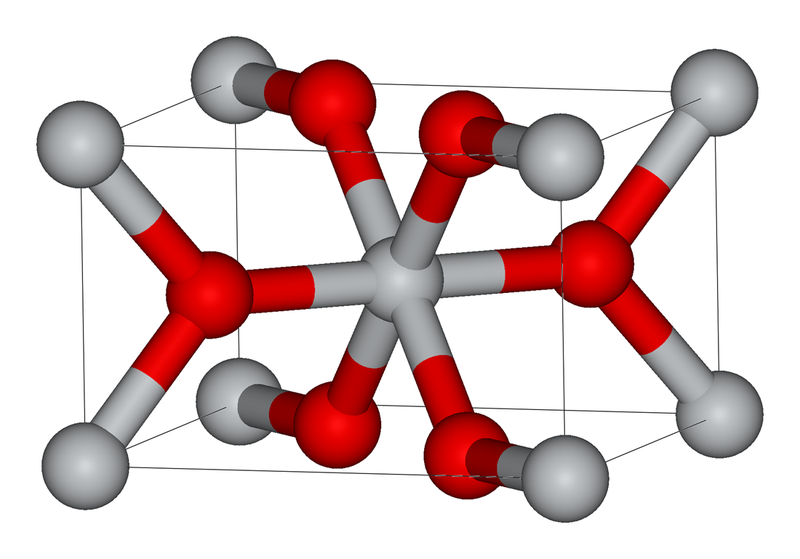
In Rutile
In the figure given about red balls represents oxygen atoms and white balls represents titanium atoms:

A.4
B.6
C.5
D.8

Answer
439.5k+ views
Hint: Before answering this question, we should first know about Rutile. Titanium oxide (
Complete answer:
The name Rutile is derived from the Latin word Rutilus(Red) as the deep red color could be observed in some species if we see it through transmitted light. Abraham Gottlob Werner discovered Rutile in 1803. The composition of natural rutile is there is 10% of iron and Niobium and tantalum.
In High temperature and pressure metamorphic rocks and igneous rocks, Rutile is a usual mineral that is used. It is considered one of the most stable polymorphs
It has a tetragonal unit cell and has a framework of unit cell i.e a = b = 4.584
Titanium atoms in titanium oxide form a bcc arrangement. This unit cell consists of two atoms per unit cell. So, x = 2
Oxygen atoms are in titanium oxide are in trigonal voids. This void’s coordination number is three. So, y = 3
Therefore, x+y = 2+3 = 5
So, Option (C) 5 is correct.
Note:
Rutile is a vital part of ore deposits and heavy minerals. Miners help in the extraction and separation of useful and valuable minerals like Zircon, ilmenite. Some of its uses are- As a pigment, in the manufacture of titanium metal, refractory ceramic.
Complete answer:
The name Rutile is derived from the Latin word Rutilus(Red) as the deep red color could be observed in some species if we see it through transmitted light. Abraham Gottlob Werner discovered Rutile in 1803. The composition of natural rutile is there is 10% of iron and Niobium and tantalum.
In High temperature and pressure metamorphic rocks and igneous rocks, Rutile is a usual mineral that is used. It is considered one of the most stable polymorphs
It has a tetragonal unit cell and has a framework of unit cell i.e a = b = 4.584
Titanium atoms in titanium oxide form a bcc arrangement. This unit cell consists of two atoms per unit cell. So, x = 2
Oxygen atoms are in titanium oxide are in trigonal voids. This void’s coordination number is three. So, y = 3
Therefore, x+y = 2+3 = 5
So, Option (C) 5 is correct.
Note:
Rutile is a vital part of ore deposits and heavy minerals. Miners help in the extraction and separation of useful and valuable minerals like Zircon, ilmenite. Some of its uses are- As a pigment, in the manufacture of titanium metal, refractory ceramic.
Latest Vedantu courses for you
Grade 10 | CBSE | SCHOOL | English
Vedantu 10 CBSE Pro Course - (2025-26)
School Full course for CBSE students
₹37,300 per year
Recently Updated Pages
Master Class 9 General Knowledge: Engaging Questions & Answers for Success

Master Class 9 English: Engaging Questions & Answers for Success

Master Class 9 Science: Engaging Questions & Answers for Success

Master Class 9 Social Science: Engaging Questions & Answers for Success

Master Class 9 Maths: Engaging Questions & Answers for Success

Class 9 Question and Answer - Your Ultimate Solutions Guide

Trending doubts
State and prove Bernoullis theorem class 11 physics CBSE

Who built the Grand Trunk Road AChandragupta Maurya class 11 social science CBSE

1 ton equals to A 100 kg B 1000 kg C 10 kg D 10000 class 11 physics CBSE

State the laws of reflection of light

One Metric ton is equal to kg A 10000 B 1000 C 100 class 11 physics CBSE

Difference Between Prokaryotic Cells and Eukaryotic Cells




